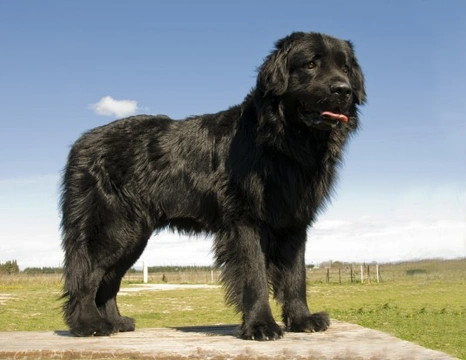
The large and lovely Newfoundland dog
The Newfoundland or “Newfie” dog is one of the largest of the canine giants, and at first glance you could be forgiven for thinking that you were looking at a big woolly bear! Fortunately, the Newfoundland has an incredibly sweet temperament and laid back attitude to life to accompany their large size, and are extremely loyal and easygoing pets. They also have a reputation for loving the water, and have one very unique trait that accompanies this- webbed feet!
Newfoundland dog origins
The Newfoundland dog is classed as a Mastiff dog, and shares many common traits with mountain dog types and molossers. They are closely related to the St. Bernard dog, and in fact many St. Bernard dogs have some Newfoundland ancestry.
The breed originated in Newfoundland (now part of Canada) as the result of out crossing of the island’s indigenous dogs (sometimes known as the Lesser Newfoundland) with imported dogs, most likely the Portuguese Mastiff, introduced by fishermen in the 16th century.
Appearance
The first thing that strikes you when you see a Newfoundland is “huge!” They are tall dogs, standing at up to 70cm or more tall at the shoulder, and sometimes ranging well over 175cm long from nose to tail. Added to this they are very heavily built, with males sometimes weighing in at over 90kg, and females usually around 55kg. They have large features; a broad back, long thick tail, thick, sturdy legs and huge paws. They have thick necks, and large, heavy-featured faces. They have an undeniable cute-appeal for all of their large size, and are sometimes described as having the appearance of a grumpy teddy, which belies their kind natures and happy dispositions.
The Newfoundland dog is most commonly seen in black or brown colours, but can also be found less commonly in grey or a colour called “Landseer,” which is white with black markings. Their coats are long and wavy with a heavy, shaggy appearance and a soft texture. They have a double-layered coat, which helps to keep them warm whatever the weather, but does require a significant amount of grooming to keep them in good condition.
Temperament
The Newfoundland dog is known as the “gentle giant” and is renowned for its docile nature, tolerance, calmness and strength. They are generally slow-moving dogs, who take everything at a sedentary pace, and have a positive and welcoming outlook to life. They are both very loyal to their owners and receptive to strangers, and easy to train, making them popular for many different working dog roles. They have a loud, rumbling bark that can prove unnerving, but the Newfoundland is most unlikely to follow this up with any aggression!
Newfoundlands and children generally make for lifelong friends, and these dogs are incredibly tolerant of kids. There does remain the small risk of little children being squashed by the dogs in play, and also the chance that small children will attempt to ride the dogs, something that should of course be discouraged!
Newfoundland dogs are also generally very tolerant of other dogs and smaller animals such as cats, and can live quite happily with other pets if properly introduced.
Health
The average lifespan of the Newfoundland dog is generally 8-10 years, which is within normal parameters for a giant breed dog. Like many large and giant breeds, the Newfoundland has elevated risk factors for hip dysplasia and elbow dysplasia, which can lead to pain and problems with mobility.
Also, subvalvular aortic stenosis or “SAS” is unfortunately a common heart defect in the Newfoundland dog, and one that can cause sudden and unexpected fatalities, often at a young age. The Newfoundland is also rather more prone than most breeds to the development of cystinuria, or bladder stones.
Swimming and water
The Newfoundland dog has a natural affinity with the water, and dogs of the breed are generally keen and confident swimmers. Their large and muscular builds ensure that they can hold their own even in tidal waters, and they have masses of stamina and endurance for swimming.
They have a very unique feature that helps to enable their swimming ability-webbed feet, making them natural water babies! Added to this, the Newfoundland’s swimming stroke doesn’t resemble the doggy paddle common to other breeds, but is more of a downwards and outwards motion, more akin to the breaststroke than any other movement. This, accompanied by their huge webbed paws, means that they can achieve maximum propulsion through the water.
The Newfoundland dog also demonstrates throughout history a strong propensity to rescue people from the water, even without receiving any training or encouragement to do so. A great number of historical accounts speak of the Newfoundland dog entering the water to aid people in distress, and either keeping the person buoyant until rescue arrived, or pulling the person in question back to land.



